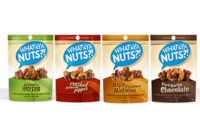![]()
In The Mix
Today’s ingredient suppliers bring convenience and consistency to bakeries, serving up everything from blends of key active ingredients to complete ready-to-use mixes
By Kathie Canning
The bakery-mix sector is the unsung hero of the wholesale-bakery world. As bakeries consolidate and find themselves with fewer and fewer skilled bakers, the ingredients folks continue to expand their research and development programs and product offerings.
Today, these suppliers offer everything from single critical ingredients to complete formulations that require only the addition of water.
Convenient and Consistent
In general, the mix category can be broken down into three categories: concentrates, bases and ready-to-use mixes.
Concentrates basically are blends of critical active ingredients such as enzymes, emulsifiers, flavors and other ingredients designed to perform tasks ranging from slashing fermentation time to improving dough machinability to enhancing shelf life. These ingredients typically are used at low levels.
Bases build on concentrates by incorporating baking basics such as sugar and shortening. They also might contain a bit of flour as a carrier. Bakers simply add ingredients such as flour, water and yeast.
Ready-to-use mixes offer the ultimate in convenience. In most cases, bakers need only add water and, depending on the application, sometimes eggs or yeast.
“Economics and baker’s skills usually will determine which of the three a bakery might use,” says Marty Ginsburg, a marketing representative with Totowa, N.J.-based Caravan Products Co. Inc.
Concentrates often offer the most economical alternatives for large wholesale bakeries, says Ginsburg, while in-store bakeries increasingly rely on the more-expensive mixes — or even the newer freeze-and-bake products. Bases offer an easy-to-use “somewhat economical” alternative for almost all bakeries.
Ingredients deemed critical for concentrates or bases, of course, will vary from one application to another. Donuts, for example, contain more sugar than flour, but the flour’s quality becomes the greater issue. Sugarless donut bases are designed with this fact in mind.
“You’re not going to see any difference between one sugar and another sugar,” says Charles Morris, manager of research for ADM Arkady, Olathe, Kan. “Larger facilities can just plain buy sugar cheaper a lot of times, and you don’t want to ship all that weight when it’s not a critical ingredient.”
Concentrates leave the most room for customization on the part of a large bakery, Morris says. Many of them are designed for use across a range of products.
Even the largest wholesale bakeries stand to benefit from concentrate use, Morris adds. “They’re bringing in bulk flour; they may be pumping their yeast in; they’ve got all the things that would make for a high-speed bakery,” he says. “But they still might rely on some of these concentrates because it allows them to avoid having those very minor ingredients lying around getting old.”
For example, says Morris, ADM Arkady offers a tortilla press blend that includes the leavening agents, the conditioners and the preservatives. “These are very minor ingredients, but they have a very, very large impact on that tortilla,” he stresses.
Bases and concentrates also lessen the probability of error during production, says Jerry Smiley, founding partner of Roselle, Ill.-based Strategic Growth Partners Inc.
“You’re using such minute portions of certain things,” he says. “But if they are doubled or halved, you’re going to have a huge difference in the performance of the product. So [bakeries] want something where all those kind of ‘funny-to-use’ items are put together for them so there’s no way to screw up.”
Ultimately — whether the bakery decides to go with a concentrate, base or mix — it’s the technology that counts, says Steve De Luca, vice president of marketing for Puratos Corp., Cherry Hill, N.J.
“Customers will buy the format that best suits them, so our challenge is to deliver the right technology,” he says. “Taste needs to be combined with unique technology to deliver products our customers want. That’s our mandate, and we’ve certainly been able to do that.”
Taking on Trends
Ingredient suppliers have the in-house expertise to formulate the blends bakeries need to meet current trends. Of course, the most significant trend over the past year or so has been toward carbohydrate reductions.
“The baking industry has taken quite a hit over the past year due to the high carb counts [of] most bakery items,” says Ginsburg. “We were forced to make mixes with [fewer] carbs by removing or replacing sugar and by substituting flour with fiber and vital wheat gluten.”
Because lower-carb baked goods typically contain a higher proportion of fiber, says De Luca, products tend to dry out unless other adjustments are made “to bring it back to a more appealing taste.” The bakery ingredients sector has leveraged its R&D expertise to create ready-to-use mixes that allow bakeries to produce a palatable product, he adds.
However, most industry observers believe the low-carb movement is losing some steam.
The focus will shift from carbohydrate removal to the inclusion of ingredients offering taste and/or health benefits, predicts Henry Nonaka, senior technical sales support manager for Westchester, Ill.-based Corn Products U.S., a business unit of Corn Products International Inc.
“The ingredients that you use to replace the carbs will now also have to confer some other benefit,” he says. “It’s either in terms of touting high dietary fiber or some other healthy aspect. And I think fortification will become even bigger as time goes on.”
Morris agrees, stressing that the mix arena could provide an easy way for bakeries to fortify products with more non-traditional healthful constituents such as isoflavones and phytosterols that would be included at very low levels.
“A lot of times, those are fairly expensive ingredients,” he says. “If you were to dose them inappropriately, the product wouldn’t be right.”
As 2006 — and its accompanying trans fatty acid labeling requirements — grows closer, the ingredient folks also are taking a closer look at different type of shortenings and their functionality in mixes and bases, says Ginsburg.
In addition, sugar reductions could become increasingly important to our nation’s growing diabetic population.
“When you have a reduction in sugar, more of a sugar substitute type of thing, it affects how the products are processed,” says Smiley. “You can’t just take out sugar and put in Splenda and have everything work the same. So I’m going to guess that there’s going to be a move toward making some of these mixes work better with artificial sweeteners.”
De Luca agrees.
“We see that people are looking for a combination of indulgence and health — a kind of healthy indulgence,” he says. “We see that in breads, in sweet goods. And we see sugar-free really taking off.”
Increasing public awareness of Celiac disease and gluten sensitivity has spurred another growth opportunity.
Traditionally, gluten-free baked goods have been problematic in terms of product taste. However, Corn Products U.S. recently introduced a line of gluten-free bakery mixes that aims to improve overall sensory quality in this sector. Based on a series of ethnic products developed by the company’s Colombian affiliate, the line of Maizing mixes and premixes features the company’s Expandex modified starch. Formulations are available for products ranging from French bread, pizza crust and muffins to Buñuelos, a traditional Colombian cheese bread.
“There seems to be a void in terms of good-tasting gluten-free products,” says Nonaka. “What we offer are baseline ingredients that will actually enable [bakeries] to make what we feel to be better-quality products from a sensory standpoint.”
The products also stand to benefit bakeries that want to get in on the growing ethnic-foods market, notes Nonaka. “If you go to any part of the world, they have their own type of specialty bakery products. We think that the Expandex modified starch, in particular, offers the benefit of traditional functionality and taste in a variety of ethnic baked goods.”
The Hispanic influence is here to stay, says Ginsburg, who notes that many ingredient companies now are adding blends for traditional items such as bolillos and conchas to their mix offerings.
Chasing Perfection
Whether opting for a concentrate, a complete mix or something in between, a bakery is sure to reap benefits in terms of technology and taste. After all, the mix suppliers possess a wealth of knowledge when it comes to both traditional and emerging ingredients and their unique interactions.
“We actually have people in a lab doing research,” stresses Morris. “We’re working with these products everyday and trying to understand how our ingredients will work in different applications. As our customers come to us with requests, we’ll put things together.”
Ingredient suppliers consider not only a mix’s composition, says De Luca, but also its performance under production conditions. For example, Puratos recently launched a new brand of dough improver that aims to further enhance machinability.
Of course, the inclusion of a superior concentrate or base does not ensure a perfect finished product. Ultimately, it is only one of a number of factors that work together to determine a product’s fate.
One common mistake bakeries make when working with mixes, bases or concentrates, says Ginsburg, is mixing in water that is too warm. Two other frequent blunders include improper mixing techniques and longer-than-necessary running times. Caravan offers a toll-free number that bakers can call to get assistance, he adds.
Bakeries also would be wise to follow the supplier’s usage recommendations — both in terms of how to handle the ingredient blends and in terms of what grades of additional ingredients best complement them.
“We present finished concepts to a variety of our customers,” says De Luca. “We say this is what this product can deliver in terms of a taste profile if you use these particular ingredients. But I don’t think anyone in the industry can control ultimately what ingredients are used.”


